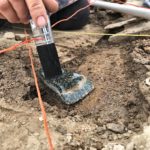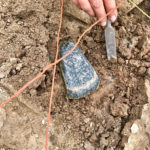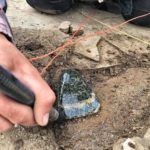 An excavation the Ness of Brodgar, a Neolithic archaeological site on the Orkney island of Mainland, has unearthed the glossiest stone axe I’ve ever seen, and prehistoric axes are one of my obsessions so I’ve seen quite a few. Even the professional archaeologists from the Ness of Brodgar Trust and the Archaeology Institute of the University of the Highlands and Islands (UHI) who have been excavating the site for years and have seen far more Neolithic axes than I were struck by the sheer beauty of this piece.
An excavation the Ness of Brodgar, a Neolithic archaeological site on the Orkney island of Mainland, has unearthed the glossiest stone axe I’ve ever seen, and prehistoric axes are one of my obsessions so I’ve seen quite a few. Even the professional archaeologists from the Ness of Brodgar Trust and the Archaeology Institute of the University of the Highlands and Islands (UHI) who have been excavating the site for years and have seen far more Neolithic axes than I were struck by the sheer beauty of this piece.
 The axe was found by Australian UHI archaeology student Therese McCormick on August 3rd. She was on a bit of a slog, digging through the dense, complex layers of floors in Structure Ten which is the largest Neolithic building in the north of Britain. It was built around 2900 B.C. and used until the abandonment of the Ness of Brodgar site around 2,400–2,200 B.C. Structure Ten was deliberately demolished after a rager of a ceremony that featured the ritual slaughter of hundreds of cows and deposition of their bones. This appears to have been the Ness of Brodgar’s Neolithic last hurrah, the site’s closing ceremony.
The axe was found by Australian UHI archaeology student Therese McCormick on August 3rd. She was on a bit of a slog, digging through the dense, complex layers of floors in Structure Ten which is the largest Neolithic building in the north of Britain. It was built around 2900 B.C. and used until the abandonment of the Ness of Brodgar site around 2,400–2,200 B.C. Structure Ten was deliberately demolished after a rager of a ceremony that featured the ritual slaughter of hundreds of cows and deposition of their bones. This appears to have been the Ness of Brodgar’s Neolithic last hurrah, the site’s closing ceremony.
 The stratigraphy of Structure Ten is therefore as important as it is challenging. Therese was working on the west end of the 82 x 66-foot structure in a test pit exposing the stratigraphy of floor depositions and leveling events when on her last day of excavation she discovered the stone axe. Made of banded gneiss with a distinctive orange band that curves at the wide end in parallel to the curvature of the cutting edge, the axe’s beauty was noticeable even when it was still covered in soil. When it was cleaned and dampened with water, the color and texture stood out even more, set off by its high-gloss polish.
The stratigraphy of Structure Ten is therefore as important as it is challenging. Therese was working on the west end of the 82 x 66-foot structure in a test pit exposing the stratigraphy of floor depositions and leveling events when on her last day of excavation she discovered the stone axe. Made of banded gneiss with a distinctive orange band that curves at the wide end in parallel to the curvature of the cutting edge, the axe’s beauty was noticeable even when it was still covered in soil. When it was cleaned and dampened with water, the color and texture stood out even more, set off by its high-gloss polish.
 The axe shows signs of extensive use. One side of it has been re-sharpened. The other was not and and is heavily worn. The sharp edge and wear pattern indicate its primary function was an axe blade, but tell-tale divots on both sides of it indicate it was also used as a sort of mini anvil. Strikes against it left small, rough dents in the surface of the stone.
The axe shows signs of extensive use. One side of it has been re-sharpened. The other was not and and is heavily worn. The sharp edge and wear pattern indicate its primary function was an axe blade, but tell-tale divots on both sides of it indicate it was also used as a sort of mini anvil. Strikes against it left small, rough dents in the surface of the stone.
Site director Nick Card said: “It is nice to find pristine examples of stone axes, but the damage on this one tells us a little bit more about the history of this particular axe.
“The fact that the cutting edge had been heavily damaged suggests that it was a working tool rather than a ceremonial object.
“We know that the buildings in the complex were roofed by stone slabs so this axe was perhaps used to cut and fashion the timber joists that held up the heavy roof.”
This is the second stone axe found in the same area of Structure Ten. One was unearthed in 2012 just above the find site of the current discovery. It too was uncommonly handsome, a shiny black granite not usually used to make axes, and had been used and reused. It had broken at one point and the cutting edge recreated on the smaller tool.
The Ness of Brodgar excavation is in dire need of funding. If you’d like to support the archaeological exploration of one of the most important Neolithic sites in Britain, you can donate online here.